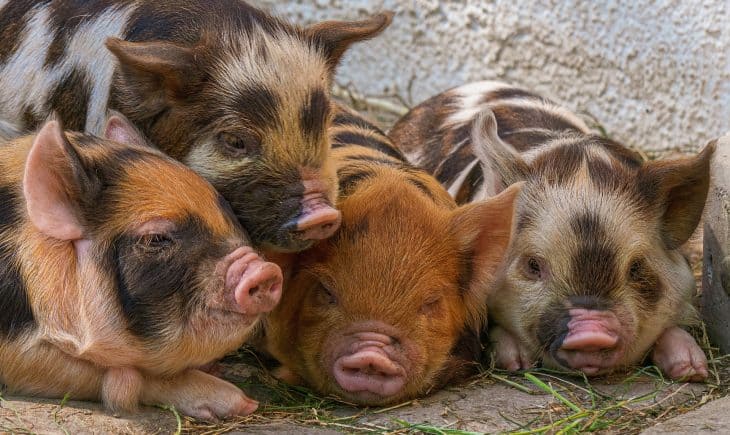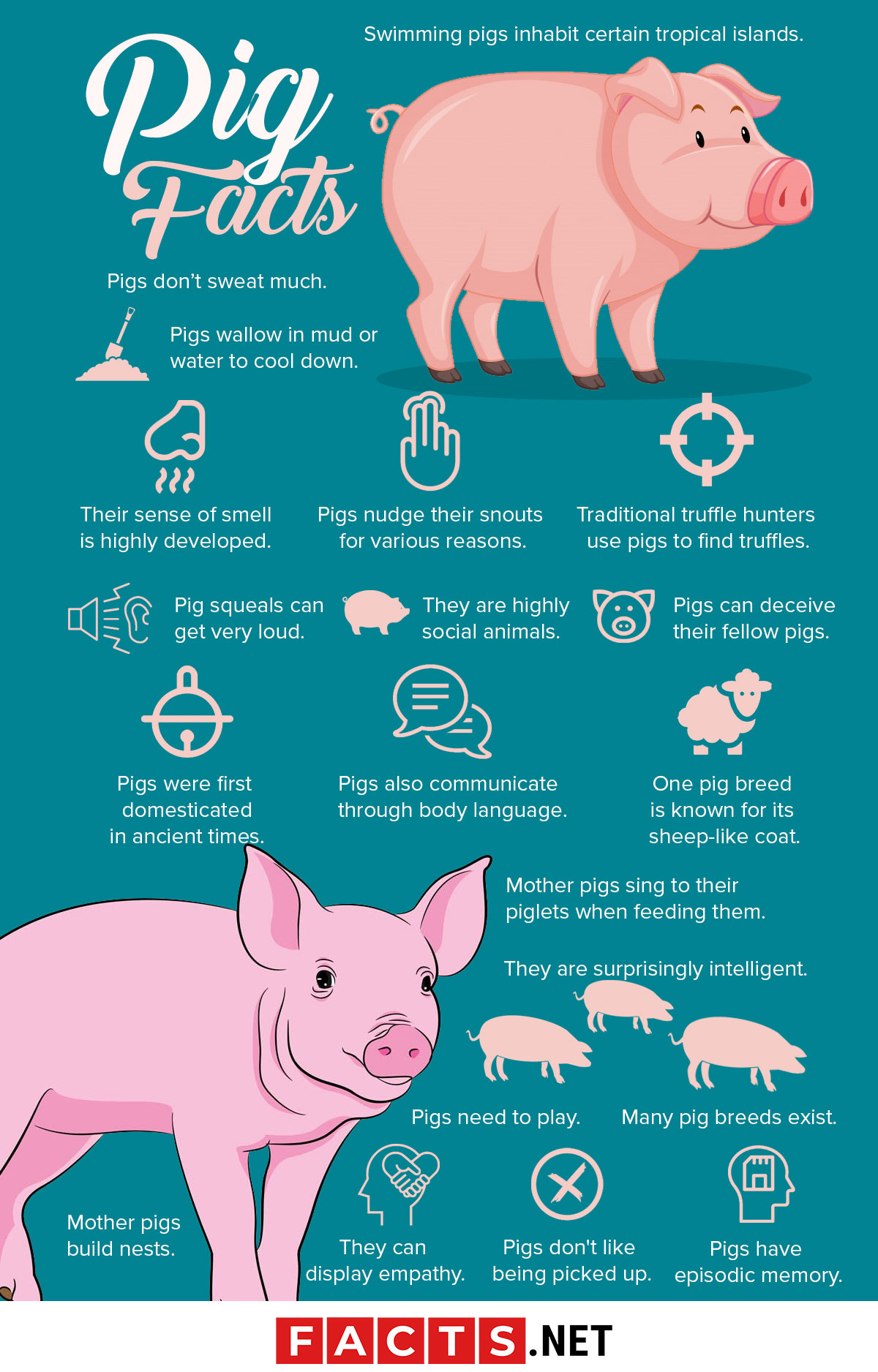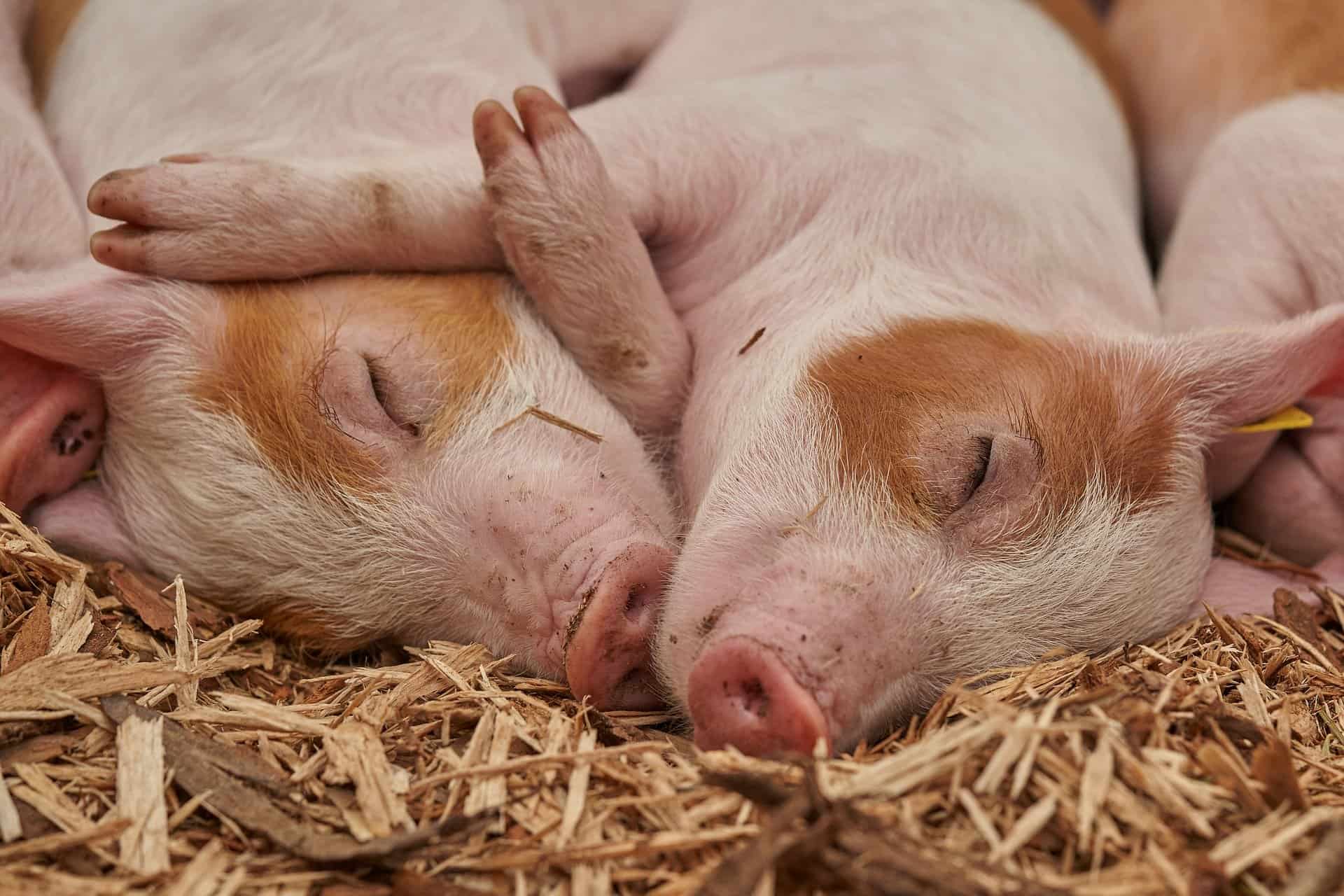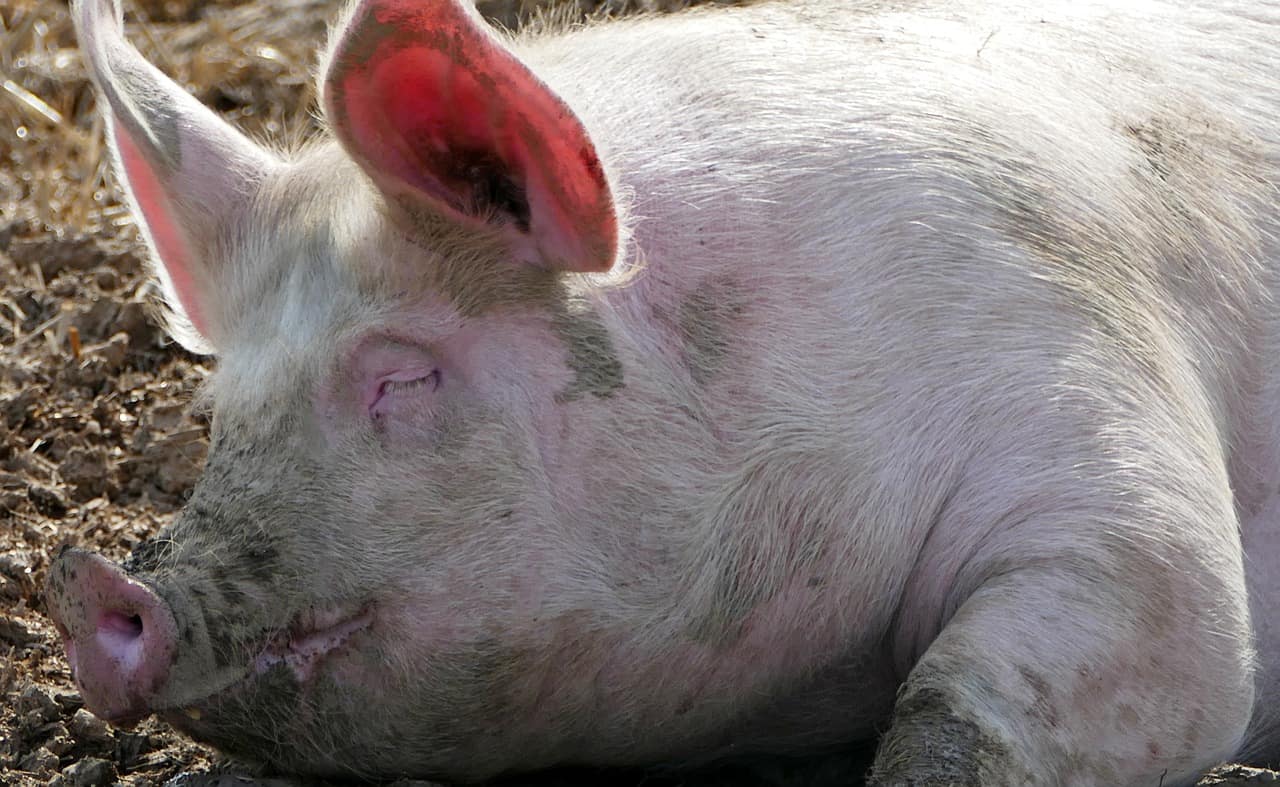
When someone compares you to a pig, it hardly ever means a good thing. However, there’s more to pigs than their loud and messy nature. Although people may view them as dirty animals, pigs are highly intelligent and sociable creatures. Different cultures portray pigs in a spectrum of ways from positive to negative meanings. But overall, they’re interesting animals no matter how you view them. Take a closer look at these curious creatures through these pig facts.
- Pigs have four toes.
- Domestic pigs live for around 15 to 20 years.
- There are currently 18 living species of the pig family Suidae.
- Pigs give birth after 112-120 days of pregnancy.
- Female pigs sexually mature at just about 3-12 months of age.
- Pigs are omnivores.
- The domestic pig’s scientific name is Sus scrofa domesticus.
- Domestic pigs are a subspecies of the wild boar.
- They are mostly farmed but occasionally kept as pets.
- Humans have domesticated pigs since ancient times.
- When piglets are weaned, they’re referred to as shoats.
- The orgasm of male pigs can last for around half an hour.
- Pigs are even-toed ungulates.
- Their meat is called pork.
- Baby pigs are called piglets.
- A group of pigs is referred to as a team, sounder, or passel.
- For traditional Irish fishermen, mentioning pigs is considered bad luck.
- Pigs have a 310° panoramic vision.
- Pig hairs usually come in the form of stiff bristles.
- They can also be called swine or hogs.
Pig Facts Infographics

Swimming pigs inhabit certain tropical islands.
The Exuma district of the Bahamas has islands fully inhabited by feral swimming pigs. Most notably, they are a tourist attraction around Pig Beach in Big Major Cay.
Since no humans ever lived on the island, it’s unclear how the pigs got there in the first place. In the meantime, the suggested theories involve pirates, sailors, or the pigs surviving a shipwreck.

Pigs don’t sweat much.
It turns out “sweating like a pig” doesn’t really say much if you consider this fact. Pigs have sweat glands, but unlike humans, pigs don’t perspire to cool themselves off. This is also true for other “hairless” mammals, such as elephants and rhinoceroses. Instead, they rely on other methods to dissipate their body heat.
Pigs wallow in mud or water to cool down.
Animals have different ways to cool off: humans sweat, dogs pant, and elephants flap their ears. Pigs don’t rely on any of those and instead roll in mud or water to avoid overheating. Researchers also suggest that rolling in the mud could also provide them with protection against parasites and sunburn.
Their sense of smell is highly developed.
Perhaps one of the most outstanding parts of a pig’s appearance is its nose. Their noses provide them with a keen sense of smell. It is highly important for finding food and communicating with other pigs. They also use pheromones to alarm other pigs of danger, able to tell each other apart using their sense of smell. How’s that for cool pig facts?
Pigs nudge their snouts for various reasons.
Pigs exhibit a behavior of nudging their snouts, referred to as rooting. Born with this behavior, rooting is an instinctual trait that piglets do to get milk from their mothers. For older pigs, rooting acts as a comforting gesture similar to a cat’s kneading, and can also be done to communicate certain things. Because of this, pet pigs can root household objects and pieces of furniture.
On the flip side, piglets can develop obsessive rooting if they are weaned off their mother’s milk too early. Since it’s such a common trait, farmers sometimes use rooting pigs to till the soil.
Traditional truffle hunters use pigs to find truffles.
Because of their great sense of smell and their rooting habits, people sometimes use pigs to look for truffles. A truffle hog can find truffles buried as deep as three ft (0.91 m) underground. It is said that the pigs are naturally drawn to the aroma of truffles because they smell similar to the sex hormones of a male pig.
Truffle hogs have been used since the Roman Empire and have been well-documented in the Renaissance. Today, dogs are more frequently used to hunt truffles because they are less likely to eat the mushrooms they find. The dogs are known as truffle hounds.
Pigs were first domesticated in ancient times.
Humans have been domesticating animals for consumption or companionship since ancient times. For pigs, their earliest domestication goes as far back as 8500 BC in the Near East. Separately, pigs have also been domesticated in ancient China.
They are highly social animals.
Pigs show social behaviors as early as just a few hours after birth. They have a “teat order” wherein the piglets establish positions on their mother’s teats. Typically, the healthier, more dominant piglets suckle on the teats closer to the mother’s head. Piglets may fight for their positions to establish a permanent teat order.
After being weaned, pigs form a social hierarchy and may fight each other over dominance when grouped together with strangers. The dominant pigs act as leaders and have the first access to food. Pigs also tend to seek out the company of fellow pigs, preferring to sleep next to one another. Definitely one for cute pig facts.
Pigs can deceive their fellow pigs.
Their intelligence and social abilities also grant pigs a form of theory of mind, or knowing that other beings have minds of their own. This allows them to deceive others who may want to use up the same resources they want.
In an experiment, researchers taught one pig where food was hidden, and the pig was followed by a naive pig. The researchers observed that the informed pig faked out the other pig to hog up the food for itself.
Pig squeals can get very loud.
With over 20 identified pig sounds, pigs communicate through oinking, grunting, and squealing. Pig squeals in particular can get as loud as 115 dB, or almost as loud as a the average rock concert at 120 dB. This is definitely one of the more interesting pig facts.
Pigs also communicate through body language.
Aside from communicating through sounds and smell, pigs also can show body language to convey their messages. Like dogs, they can wag their tails when excited. They can also smile, cry, or nudge you with their snouts. Moreover, when piglets are cold, they tend to huddle together.

They are surprisingly intelligent.
Pigs are self-aware and can recognize themselves in a mirror, a feat that only few animals can do. They can understand how reflections work and can locate food using the reflections as a guide.
Pigs are also regarded as smarter than even dogs, learning tricks fairly quickly and can even be trained to herd sheep and play video games. Some aspects of their intelligence are also comparable to those of primates.
Pigs need to play.
Because of their level of intelligence, pigs naturally get bored when they have nothing to do. Pigs are playful and curious animals, so it’s ideal to give them enrichment in the form of toys or activities. Like most domesticated pets, the lack stimulation may lead to pigs developing destructive behavior. This is one of the pig facts that will be important if you want to get a pet pig.
Pigs have episodic memory.
Not only are they intelligent, but pigs also posses an extremely vivid memory. Unlike other animals, pigs are unlikely to forget what they’ve learned. With their episodic memory, pigs have the ability to remember specific events in their lives.
Many pig breeds exist.
There are hundreds of known breeds of domestic pigs, coming in different shapes and sizes. Some breeds, such as the Mulefoot, Ossabaw Island hog, and the Choctaw hog, are considered critically endangered and nearing extinction. The smallest breed is the Göttingen minipig, commonly kept as a pet pig.
One pig breed is known for its sheep-like coat.
The Mangalica, sometimes referred to as “sheep-pig,” has a thick coat of hair that resembles the woolly fur of sheep. Unlike the wool of sheep, however, the hairs of Mangalica pigs are coarse and stiff.
This breed of pig was developed in Hungary and has a high concentration of fat. The breed almost died from the 1980s to the 1990s out but has risen again in popularity, with reports of breeding up to 60,000 piglets per year.
Pigs don't like being picked up.
As prey animals, pigs evolved to fear the sensation of being picked up, since that usually meant they would be a predator’s next meal. Pet owners who want to cuddle their pigs may prevent this by training them as piglets or making sure to support their legs as they’re carried.
Mother pigs build nests.
Prior to giving birth, female pigs or sows make nests by digging soil and putting twigs and leaves in the burrow. The mother pig would form a mound with the gathered materials, moving softer materials to the center.
They then root around to create the nest, where they would lie down to give birth. This particular behavior makes pigs unique from other even-toed ungulates (such as cows and camels) that give birth while standing up.
Mother pigs sing to their piglets when feeding them.
Every hour or so, a mother pig nurses her young. The piglets grunt to let their mother know when they’re hungry. As she feeds her young, mother pigs grunt with a regular interval – varying her tone and loudness as if she were singing. Through these sounds, the piglets would be assured that her milk is flowing.
They can display empathy.
Like many social animals, pigs can empathize with other pigs. They can connect with other pigs emotionally and reflect those emotions. For example, when a pig gets excited about something like music, the other pigs will get excited as well even if they haven’t had any prior experience with the music.
The death of a pig once caused a war.
In 1959, a 13-year confrontation sparked between the United States and Britain after an American settler shot a pig owned by a British man on San Juan Island, a territory claimed by both nations.
This conflict is often referred to as the “pig war”. The dispute ended up bloodless, save for the pig that sparked the beginning of the conflict. How’s that for interesting pig facts?
Pigs were also used in war.
There are various accounts of pigs being used in ancient wars. War pigs are reportedly highly effective against war elephants, because the elephants were terrified of the squealing pigs. In 275 BC, ancient Romans used war pigs to frighten the war elephants of Pyrrhus.
Some armies started to raise pigs and elephants together to make them less afraid of pigs. However, in the siege of Megara in 266 BC, the Megarians set pigs on fire with resin and drove them towards the opposing army’s war elephants. The elephants, in their terror, trampled and killed many of the army’s men.
Giant pigs used to run rampant on Earth.
The Entelodont, nicknamed as terminator pigs or hell pigs, were large omnivores that roamed the Earth around 37-16 million years ago from the Eocene to the Miocene epochs. They had large canines and powerful jaws that allowed them to scavenge meat and eat a variety of foods, such as small mammals and tough vegetation.
Pigs sleep almost as much as humans.
Goats, sheep, and cattle typically only sleep for a short period of time. Pigs, however, need to sleep for almost eight hours a day, which is almost as much as humans. Scientists also believe that similar to humans, pigs can also dream during REM sleep.

Pigs are valuable in research.
Domestic pigs are often used in biomedical research because of their similarities to humans, such as in skin and heart valves. Because pigs share many genetic traits with humans, pig samples tend to be used as specimen in scientific studies.
These involve pre-clinical trials, developing more advanced medical instruments, and finding cures for certain human diseases, such as genetic disorders and diabetes.
They could potentially become organ donors to humans.
Because pigs and humans share a similar anatomy, pigs are regarded as the best potential non-human organ donors. Pigs are domesticated and abundant, making organs readily available and less susceptible to wild diseases. However, more studies are needed to successfully do the transplants without complications.
They run fast.
Domestic pigs can run up to 11 mph (17.7 km/h), with the ability to navigate in zigzag motions to escape would-be predators. Their wild cousins, however, aren’t as heavy as domestic pigs and can run at speeds of up to 15 mph (24 km/h).
Pigs have relatively small lungs.
In relation to the size of their bodies, pigs have small lungs. This makes pigs susceptible to respiratory illnesses such as pneumonia and bronchitis. In fact, a 1996 study found that as much as 30-80% of farmed pigs had lung lesions related to pneumonia.
The skulls of wild pigs change shape upon domestication.
Although wild pigs and domestic pigs belong to the same species, Sus scrofa, their skulls differ in shape. Researchers found that when wild pigs begin to get domesticated, the shape of their skulls change. This also holds true when domesticated pigs become feral.
Afghanistan is home to only one pig.
Eating pigs is considered taboo in some cultures and religions. A notable example is the Islamic religion, which is the predominant religion in Afghanistan. For this reason, Afghanistan does not raise pigs for consumption. However, there is one pig in the country, and his name is Khanzir.
Khanzir’s name literally translates to pig, and the lone pig lives in Kabul Zoo. He originally had a mate and some piglets, but they tragically died after being attacked by a brown bear, leaving Khanzir on his own. Because of this, Khanzir shares a special bond with his caretakers.
Was this page helpful?
Our commitment to delivering trustworthy and engaging content is at the heart of what we do. Each fact on our site is contributed by real users like you, bringing a wealth of diverse insights and information. To ensure the highest standards of accuracy and reliability, our dedicated editors meticulously review each submission. This process guarantees that the facts we share are not only fascinating but also credible. Trust in our commitment to quality and authenticity as you explore and learn with us.
